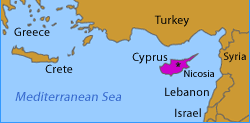Start date: 1974
Length: 187 miles
Official purpose: Defense of Turkish Cypriots
The island of Cyprus lies in the Mediterranean Sea, and its recent history has been dominated by the longer historical conflict between Greece and Turkey. Approximately 77 percent of Cypriots are Greek, and 18 percent are Turkish. In 1974, an Athens-backed junta took control of Cyprus; Turkey responded by invading the north (about one third of the island) and giving Turkish Cypriots control of that region. Turkish Cypriots declared the independent Turkish Republic of Northern Cyprus in 1983, but no country other than Turkey has accepted its legitimacy. The island’s only internationally accepted government is the Republic of Cyprus, led by Greek Cypriots.
The 1974 cease-fire line came to be known as the “Green Line.” Turkey built a barrier along the Green Line, with concrete walls, barbed-wire fencing, military outposts, and some minefields. The barrier is now 187 miles long and splits the capital, Nicosia, in two. Turkey maintains approximately 30,000 troops in the north, many of them stationed along the barrier. Additionally, United Nations peacekeeping forces maintain a presence along the Green Line.
In April 2003, Turkish Cypriot authorities substantially reduced restrictions on travel across the barrier. This was an important step in the thawing of relations between Greek and Turkish Cypriots (and, perhaps, between Greece and Turkey). Though the country remains divided, Cyprus is now a member of the European Union (EU); Turkey knows that its involvement on the island will play a role in its own bid for EU membership. To that end, Turkey has agreed to recognize Cyprus as an EU member, while asserting that this will not equal full diplomatic recognition.
- Previous: Botswana/Zimbabwe
- Next: India/Bangladesh



